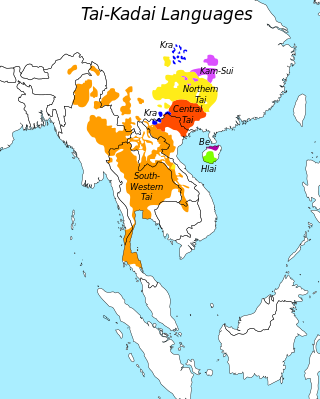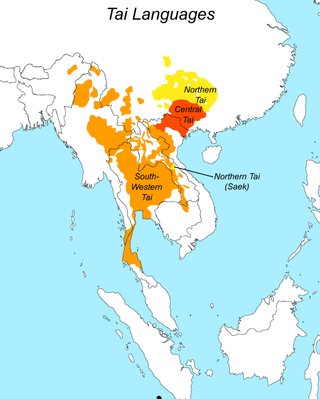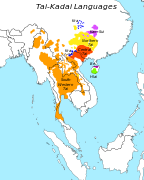- Distribution of Sino-Tibetan languages
- Distribution of Tai–Kadai languages
- Dispersal of Austronesian languages
Related Research Articles

Sino-Tibetan is a family of more than 400 languages, second only to Indo-European in number of native speakers. Around 1.4 billion people speak a Sino-Tibetan language. The vast majority of these are the 1.3 billion native speakers of Sinitic languages. Other Sino-Tibetan languages with large numbers of speakers include Burmese and the Tibetic languages. Four United Nations member states have a Sino-Tibetan language as their main native language. Other languages of the family are spoken in the Himalayas, the Southeast Asian Massif, and the eastern edge of the Tibetan Plateau. Most of these have small speech communities in remote mountain areas, and as such are poorly documented.

The Kra–Dai languages, are a language family in mainland Southeast Asia, southern China, and northeastern India. All languages in the family are tonal, including Thai and Lao, the national languages of Thailand and Laos, respectively. Around 93 million people speak Kra–Dai languages; 60% of those speak Thai. Ethnologue lists 95 languages in the family, with 62 of these being in the Tai branch.

The Austronesian languages are a language family widely spoken throughout Maritime Southeast Asia, parts of Mainland Southeast Asia, Madagascar, the islands of the Pacific Ocean and Taiwan. They are spoken by about 328 million people. This makes it the fifth-largest language family by number of speakers. Major Austronesian languages include Malay, Javanese, Sundanese, Tagalog, Malagasy and Cebuano. According to some estimates, the family contains 1,257 languages, which is the second most of any language family.

The Hmong–Mien languages are a highly tonal language family of southern China and northern Southeast Asia. They are spoken in mountainous areas of southern China, including Guizhou, Hunan, Yunnan, Sichuan, Guangxi, Guangdong and Hubei provinces; the speakers of these languages are predominantly "hill people", in contrast to the neighboring Han Chinese, who have settled the more fertile river valleys.

The Austric languages are a proposed language family that includes the Austronesian languages spoken in Taiwan, Maritime Southeast Asia, the Pacific Islands, and Madagascar, as well as Kra–Dai and Austroasiatic languages spoken in Mainland Southeast Asia and South Asia. A genetic relationship between these language families is seen as plausible by some scholars, but remains unproven.
The Kam–Tai languages, also called Dong–Tai or Zhuang–Dong in China, are a proposed primary branch of the Kra–Dai language family. However, since the 2000s in China, the names Dong–Tai and Zhuang–Dong have been used to refer to the entire Kra–Dai language family, including the Kra languages, due to the extensive documentation and comparative work done on Kra languages in China starting from the 2000s.

The Austro-Tai languages, sometimes also Austro-Thai languages, are a proposed language family that comprises the Austronesian languages and Kra–Dai languages.
The Kra languages are a branch of the Kra–Dai language family spoken in southern China and in northern Vietnam.

The Tibeto-Burman languages are the non-Sinitic members of the Sino-Tibetan language family, over 400 of which are spoken throughout the Southeast Asian Massif ("Zomia") as well as parts of East Asia and South Asia. Around 60 million people speak Tibeto-Burman languages. The name derives from the most widely spoken of these languages, Burmese and the Tibetic languages, which also have extensive literary traditions, dating from the 12th and 7th centuries respectively. Most of the other languages are spoken by much smaller communities, and many of them have not been described in detail.
Laurent Sagart is a senior researcher at the Centre de recherches linguistiques sur l'Asie orientale unit of the French National Centre for Scientific Research (CNRS).
There have been various classification schemes for Southeast Asian languages.
Proto-Tibeto-Burman is the reconstructed ancestor of the Tibeto-Burman languages, that is, the Sino-Tibetan languages, except for Chinese. An initial reconstruction was produced by Paul K. Benedict and since refined by James Matisoff. Several other researchers argue that the Tibeto-Burman languages sans Chinese do not constitute a monophyletic group within Sino-Tibetan, and therefore that Proto-Tibeto-Burman was the same language as Proto-Sino-Tibetan.
Proto-Hmong–Mien (PHM), also known as Proto-Miao–Yao, is the reconstructed ancestor of the Hmong–Mien languages. Lower-level reconstructions include Proto-Hmongic and Proto-Mienic.

Tai peoples are the populations who speak the Tai languages. There are a total of about 93 million people of Tai ancestry worldwide, with the largest ethnic groups being Dai, Thai, Isan, Tai Yai (Shan), Lao, Tai Ahom, Tai Kassay and some Northern Thai peoples.
Scott DeLancey is an American linguist from the University of Oregon. His work focuses on typology and historical linguistics of Tibeto-Burman languages as well as North American indigenous languages such as the Penutian family, particularly the Klamath. His research is known for its diversity of its thematic and theoretical reach.

The Mainland Southeast Asia linguistic area is a sprachbund including languages of the Sino-Tibetan, Hmong–Mien, Kra–Dai, Austronesian and Austroasiatic families spoken in an area stretching from Thailand to China. Neighbouring languages across these families, though presumed unrelated, often have similar typological features, which are believed to have spread by diffusion. James Matisoff referred to this area as the "Sinosphere", contrasted with the "Indosphere", but viewed it as a zone of mutual influence in the ancient period.
Proto-Sino-Tibetan (PST) is the linguistic reconstruction of the Sino-Tibetan proto-language and the common ancestor of all languages in it, including the Sinitic languages, the Tibetic languages, Yi, Bai, Burmese, Karen, Tangut, and Naga. Paul K. Benedict (1972) placed a particular emphasis on Old Chinese, Classical Tibetan, Jingpho, Written Burmese, Garo, and Mizo in his discussion of Proto-Sino-Tibetan.
The East Asian languages are a language family proposed by Stanley Starosta in 2001. The proposal has since been adopted by George van Driem and others.
Proto-Kra–Dai is the proposed reconstructed ancestor of the Kra–Dai languages.

The Old Yue language is an unattested, unclassified language, or group(s) of various languages, spoken in ancient southern China, and northern Vietnam circa 700 BCE or later. It can refer to Yue, which was spoken in the realm of Yue during the Spring and Autumn period, or to the different languages spoken by the Baiyue. Possible languages spoken by them may have been of Kra–Dai, Hmong–Mien, Austronesian, Austroasiatic and other origins.
References
- ↑ Sagart, L. (1990) "Chinese and Austronesian are genetically related". Paper presented at the 23rd International Conference on Sino-Tibetan Languages and Linguistics, October 1990, Arlington, Texas.
- ↑ Sagart, Laurent (2005). "Sino-Tibetan–Austronesian: an updated and improved argument". In Sagart, Laurent; Blench, Roger; Sanchez-Mazas, Alicia (eds.). The Peopling of East Asia: Putting Together Archaeology, Linguistics and Genetics . London: Routledge Curzon. pp. 161–176. ISBN 978-0-415-32242-3.
- ↑ Sagart, Laurent (2004). "The higher phylogeny of Austronesian and the position of Tai-Kadai". Oceanic Linguistics. 43 (2): 411–444. doi:10.1353/ol.2005.0012. JSTOR 3623364. S2CID 49547647.
- 1 2 Li, Paul Jenkuei (1995). "Is Chinese genetically related to Austronesian?". In Wang, William S-Y. (ed.). The Ancestry of the Chinese Language. Journal of Chinese Linguistics Monograph Series. Vol. 8. Chinese University Press. pp. 92–112. JSTOR 23826144.
- 1 2 Blust, Robert (1995). "An Austronesianist looks at Sino-Austronesian". In Wang, William S-Y. (ed.). The Ancestry of the Chinese Language. Journal of Chinese Linguistics Monograph Series. Vol. 8. Chinese University Press. pp. 283–298. JSTOR 23826144.
- 1 2 Vovin, Alexander (1997). "The comparative method and ventures beyond Sino-Tibetan". Journal of Chinese Linguistics. 25 (2): 308–336. JSTOR 23756693.
- ↑ Starosta, Stanley (2005). "Proto-East Asian and the origin and dispersal of languages of east and southeast Asia and the Pacific". In Sagart, Laurent; Blench, Roger; Sanchez-Mazas, Alicia (eds.). The Peopling of East Asia: Putting Together Archaeology, Linguistics and Genetics . London: Routledge Curzon. pp. 182–197. ISBN 978-0-415-32242-3.
- ↑ Ostapirat, Weera (2005). "Kra–Dai and Austronesian: Notes on phonological correspondences and vocabulary distribution". In Sagart, Laurent; Blench, Roger; Sanchez-Mazas, Alicia (eds.). The Peopling of East Asia: Putting Together Archaeology, Linguistics and Genetics . London: Routledge Curzon. pp. 107–131. ISBN 978-0-415-32242-3.
- ↑ Blust, Robert (2014). "Some Recent Proposals Concerning the Classification of the Austronesian Languages". Oceanic Linguistics. 53 (2): 300–391. doi:10.1353/ol.2014.0025. JSTOR 43286532. S2CID 144931249.
- ↑ Sagart, Laurent (2016). "The wider connections of Austronesian: A response to Blust (2009)". Diachronica. 33 (2): 255–281. doi:10.1075/dia.33.2.04sag.
- ↑ van Driem, G. 1998. ‘Neolithic correlates of ancient Tibeto-Burman migrations’, pp. 67–102 in Roger Blench and Matthew Spriggs, eds., Archaeology and Language II. London: Routledge.
- ↑ van Driem, G. 2005. ‘Sino-Austronesian vs. Sino-Caucasian, Sino-Bodic vs. Sino-Tibetan, and Tibeto-Burman as default theory’, pp. 285–338 in Yogendra Prasada Yadava, Govinda Bhattarai, Ram Raj Lohani, Balaram Prasain and Krishna Parajuli, eds., Contemporary Issues in Nepalese Linguistics. Kathmandu: Linguistic Society of Nepal.
- ↑ van Driem, George. 2016. ‘The Eastern Himalayan corridor in prehistory [usurped] ’, pp. 467-524, Vol. II in Elena Nikolaevna Kolpačkova, ed., Проблемы китайского и общего языкознания — Problems in Chinese and General Linguistics. St. Petersburg: Izdatel’stvo Studija « NP-Print ».



